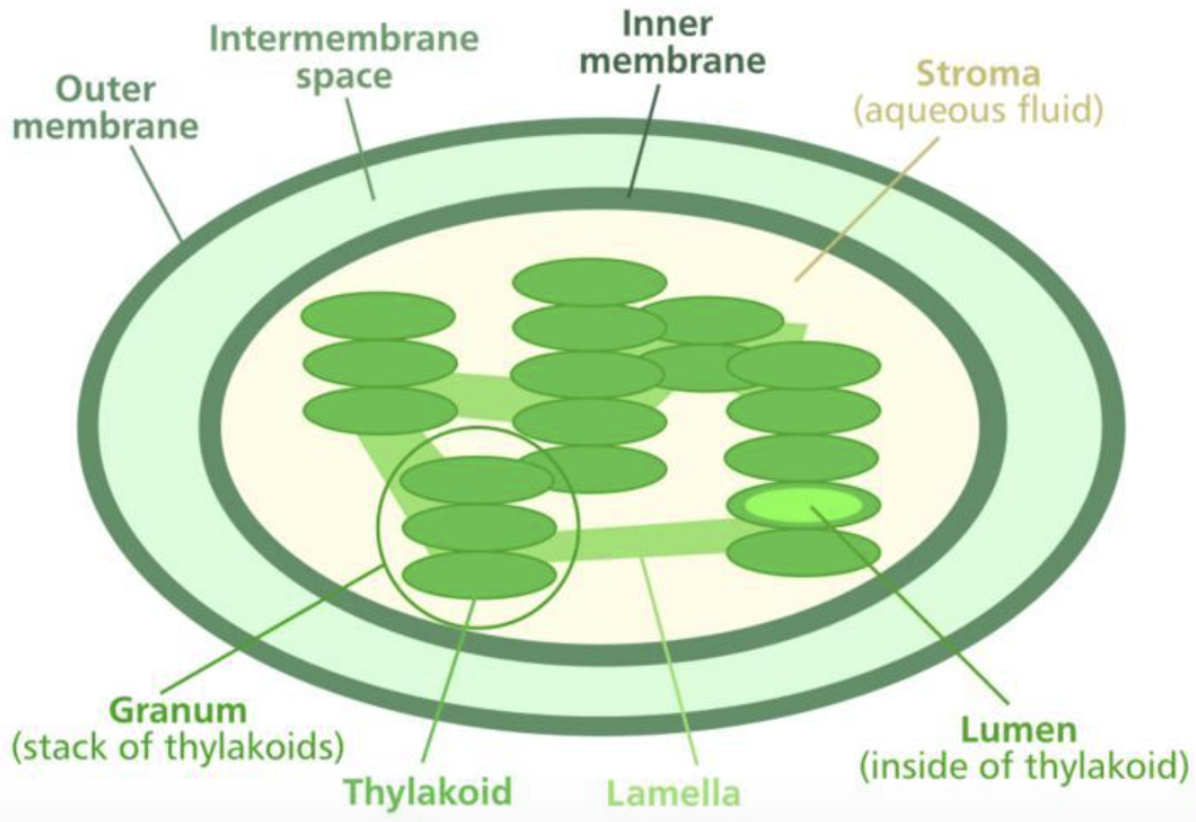
In chloroplasts, the chlorophyll is present in the
(a) Stroma
(b) Outer membrane
(c) Inner membrane
(d) Thylakoids
Answer
478.8k+ views
Hint: Chloroplasts carry out a number of functions in the plant including fatty acid and amino acid synthesis. Chlorophyll molecules are highly reactive and need to be present in specific organelles to carry out their designated function.
Complete answer:
- Chlorophyll is a pigment necessary for photosynthesis where it helps plants to absorb energy from light. It is located in the thylakoid membranes of the chloroplasts.
- Thylakoids are membrane-bound compartments present inside chloroplasts. The compartment consists of the thylakoid membrane, where chlorophyll exists, and thylakoid lumen. The thylakoid membrane is where the light-dependent reactions of photosynthesis occur.
- Individual thylakoid discs are stacked on top of each other known as a granum (plural: grana) . These stacks are present in the stroma i.e. the matrix of the chloroplast.

So, the correct answer is ‘Thylakoids’.
Additional Information:
- The grana are connected to each other by lamellae or stroma thylakoids.
- Stroma is the colorless matrix that surrounds the grana in the chloroplast. It is the site for Calvin cycle reactions and chloroplast DNA replication.
- The inner and outer membrane form the parts of the chloroplast envelope. They both are lipid bilayers and while the outer membrane is permeable, the inner membrane is highly selective and contains transport proteins.
Note:
- In some
- The thylakoid membrane is also a site for ATP synthesis.
- Photosynthetic pigments present in the thylakoid are chlorophyll a, chlorophyll b, carotenoids (carotene and xanthophylls) , and plastoquinone.
- Chloroplasts contain 10-100 grana.
Complete answer:
- Chlorophyll is a pigment necessary for photosynthesis where it helps plants to absorb energy from light. It is located in the thylakoid membranes of the chloroplasts.
- Thylakoids are membrane-bound compartments present inside chloroplasts. The compartment consists of the thylakoid membrane, where chlorophyll exists, and thylakoid lumen. The thylakoid membrane is where the light-dependent reactions of photosynthesis occur.
- Individual thylakoid discs are stacked on top of each other known as a granum (plural: grana) . These stacks are present in the stroma i.e. the matrix of the chloroplast.

So, the correct answer is ‘Thylakoids’.
Additional Information:
- The grana are connected to each other by lamellae or stroma thylakoids.
- Stroma is the colorless matrix that surrounds the grana in the chloroplast. It is the site for Calvin cycle reactions and chloroplast DNA replication.
- The inner and outer membrane form the parts of the chloroplast envelope. They both are lipid bilayers and while the outer membrane is permeable, the inner membrane is highly selective and contains transport proteins.
Note:
- In some
- The thylakoid membrane is also a site for ATP synthesis.
- Photosynthetic pigments present in the thylakoid are chlorophyll a, chlorophyll b, carotenoids (carotene and xanthophylls) , and plastoquinone.
- Chloroplasts contain 10-100 grana.
Recently Updated Pages
Master Class 11 Economics: Engaging Questions & Answers for Success

Master Class 11 Business Studies: Engaging Questions & Answers for Success

Master Class 11 Accountancy: Engaging Questions & Answers for Success

Master Class 11 English: Engaging Questions & Answers for Success

Master Class 11 Computer Science: Engaging Questions & Answers for Success

Master Class 11 Maths: Engaging Questions & Answers for Success

Trending doubts
State and prove Bernoullis theorem class 11 physics CBSE

1 ton equals to A 100 kg B 1000 kg C 10 kg D 10000 class 11 physics CBSE

State the laws of reflection of light

One Metric ton is equal to kg A 10000 B 1000 C 100 class 11 physics CBSE

1 Quintal is equal to a 110 kg b 10 kg c 100kg d 1000 class 11 physics CBSE

Difference Between Prokaryotic Cells and Eukaryotic Cells




